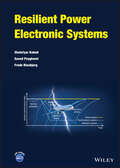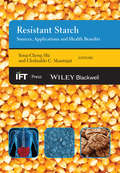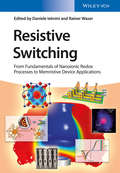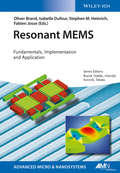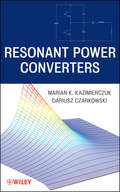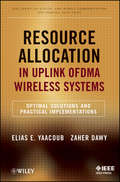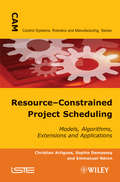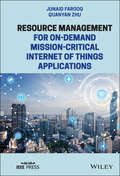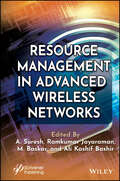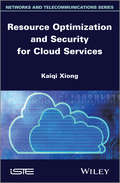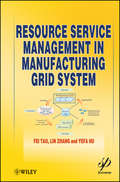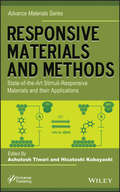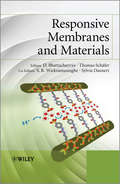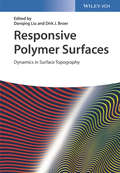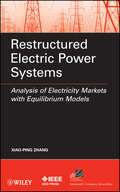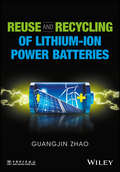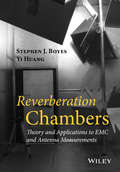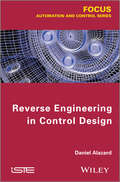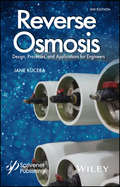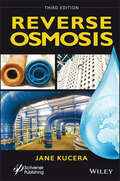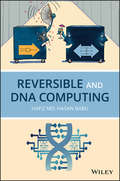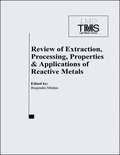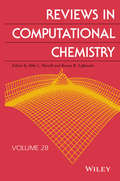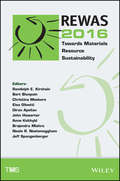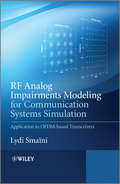- Table View
- List View
Resilient Power Electronic Systems
by Saeed Peyghami Frede Blaabjerg Shahriyar KaboliResilient Power Electronic Systems Discover an advanced reference offering a powerful novel approach to the design and use of reliable and fault-tolerant power electronic systems In Resilient Power Electronic Systems, a team of accomplished researchers deliver an insightful treatment of the challenges faced by practitioners and researchers working with power electronic converters and attempting to analyze internal and external failure mechanisms. The authors expertly present advanced techniques for reducing noise effects on fault detection and prognosis. Comprised of thirteen chapters, the authors discuss the concepts of resilience and effective operative life in the context of power electronics. The differences between reliable and efficient systems are discussed, as well as the nature of these differences in complex systems. Finally, the book explores various methods to improve the resilience of power converters. Resilient Power Electronic Systems is packed with features, including illustrations, practice problems, and PowerPoint presentations. The book also includes: A thorough introduction to the application of power electronics in various industries, as well as the concept of resilience in a power converter Comprehensive explorations of resilience against fault tolerance, including fault-tolerant power converters and resilient power converters Practical discussions of the state-of-the-art in resilient power converters, including examinations of mission-critical applications In-depth examinations of internal and external fault in power converters with mission-critical applications Resilient Power Electronic Systems is an indispensable resource for researchers, professionals, and postgraduate students studying power electronics. It’s also an ideal reference for research and development engineers working with the design and development of power electronic converters.
Resistant Starch: Sources, Applications and Health Benefits (Institute of Food Technologists Series #75)
by Daniel Granato Gastón AresThe discovery of resistant starch is considered one of the major developments in our understanding of the importance of carbohydrates for health in the past twenty years. Resistant starch, which is resistant to digestion and absorption in the human small intestine with complete or partial fermentation in the large intestine, is naturally present in foods. Resistant Starch: Sources, Applications and Health Benefits covers the intrinsic and extrinsic sources of resistant starch in foods, and compares different methods of measuring resistant starch and their strengths and limitations. Applications in different food categories are fully covered, with descriptions of how resistant starch performs in bakery, dairy, snack, breakfast cereals, pasta, noodles, confectionery, meat, processed food and beverage products.
Resistive Switching
by Daniele Ielmini Rainer WaserWith its comprehensive coverage, this reference introduces readers to the wide topic of resistance switching, providing the knowledge, tools, and methods needed to understand, characterize and apply resistive switching memories. Starting with those materials that display resistive switching behavior, the book explains the basics of resistive switching as well as switching mechanisms and models. An in-depth discussion of memory reliability is followed by chapters on memory cell structures and architectures, while a section on logic gates rounds off the text. An invaluable self-contained book for materials scientists, electrical engineers and physicists dealing with memory research and development.
Resonant MEMS
by Gary K. Fedder Jan G. Korvink Osamu Tabata Fabien Josse Oliver Brand Isabelle Dufour Stephen Heinrich Christofer HieroldPart of the AMN book series, this book covers the principles, modeling and implementation as well as applications of resonant MEMS from a unified viewpoint. It starts out with the fundamental equations and phenomena that govern the behavior of resonant MEMS and then gives a detailed overview of their implementation in capacitive, piezoelectric, thermal and organic devices, complemented by chapters addressing the packaging of the devices and their stability. The last part of the book is devoted to the cutting-edge applications of resonant MEMS such as inertial, chemical and biosensors, fluid properties sensors, timing devices and energy harvesting systems.
Resonant Power Converters
by Marian K. Kazimierczuk Dariusz CzarkowskiThis book is devoted to resonant energy conversion in power electronics. It is a practical, systematic guide to the analysis and design of various dc-dc resonant inverters, high-frequency rectifiers, and dc-dc resonant converters that are building blocks of many of today's high-frequency energy processors. Designed to function as both a superior senior-to-graduate level textbook for electrical engineering courses and a valuable professional reference for practicing engineers, it provides students and engineers with a solid grasp of existing high-frequency technology, while acquainting them with a number of easy-to-use tools for the analysis and design of resonant power circuits. Resonant power conversion technology is now a very hot area and in the center of the renewable energy and energy harvesting technologies.
Resource Allocation in Uplink OFDMA Wireless Systems: Optimal Solutions and Practical Implementations (IEEE Series on Digital & Mobile Communication #24)
by Elias Yaacoub Zaher DawyTackling problems from the least complicated to the most, Resource Allocation in Uplink OFDMA Wireless Systems provides readers with a comprehensive look at resource allocation and scheduling techniques (for both single and multi-cell deployments) in uplink OFDMA wireless networks—relying on convex optimization and game theory to thoroughly analyze performance. Inside, readers will find topics and discussions on: Formulating and solving the uplink ergodic sum-rate maximization problem Proposing suboptimal algorithms that achieve a close performance to the optimal case at a considerably reduced complexity and lead to fairness when the appropriate utility is used Investigating the performance and extensions of the proposed suboptimal algorithms in a distributed base station scenario Studying distributed resource allocation where users take part in the scheduling process, and considering scenarios with and without user collaboration Formulating the sum-rate maximization problem in a multi-cell scenario, and proposing efficient centralized and distributed algorithms for intercell interference mitigation Discussing the applicability of the proposed techniques to state-of-the-art wireless technologies, LTE and WiMAX, and proposing relevant extensions Along with schematics and figures featuring simulation results, Resource Allocation in Uplink OFDMA Wireless Systems is a valuable book for?wireless communications and cellular systems professionals and students.
Resource-Constrained Project Scheduling: Models, Algorithms, Extensions and Applications (Wiley-iste Ser.)
by Sophie Demassey Emmanuel Néron Christian ArtiguesThis title presents a large variety of models and algorithms dedicated to the resource-constrained project scheduling problem (RCPSP), which aims at scheduling at minimal duration a set of activities subject to precedence constraints and limited resource availabilities. In the first part, the standard variant of RCPSP is presented and analyzed as a combinatorial optimization problem. Constraint programming and integer linear programming formulations are given. Relaxations based on these formulations and also on related scheduling problems are presented. Exact methods and heuristics are surveyed. Computational experiments, aiming at providing an empirical insight on the difficulty of the problem, are provided. The second part of the book focuses on several other variants of the RCPSP and on their solution methods. Each variant takes account of real-life characteristics which are not considered in the standard version, such as possible interruptions of activities, production and consumption of resources, cost-based approaches and uncertainty considerations. The last part presents industrial case studies where the RCPSP plays a central part. Applications are presented in various domains such as assembly shop and rolling ingots production scheduling, project management in information technology companies and instruction scheduling for VLIW processor architectures.
Resource Management for On-Demand Mission-Critical Internet of Things Applications (IEEE Press)
by Junaid Farooq Quanyan ZhuRESOURCE MANAGEMENT FOR ON-DEMAND MISSION-CRITICAL INTERNET OF THINGS APPLICATIONS Discover an insightful and up-to-date treatment of resource management in Internet of Things technology In Resource Management for On-Demand Mission-Critical Internet of Things Applications, an expert team of engineers delivers an insightful analytical perspective on modeling and decision support for mission-critical Internet of Things applications. The authors dissect the complex IoT ecosystem and provide a cross-layer perspective on the design and operation of IoT, especially in the context of smart and connected communities. The book offers an economic perspective on resource management in IoT systems with a particular emphasis on three main areas: spectrum management via reservation, allocation of cloud/fog resources to IoT applications, and resource provisioning to smart city service requests. It leverages theories from dynamic mechanism design, optimal control theory, and spatial point processes, providing an overview of integrated decision-making frameworks. Finally, the authors discuss future directions and relevant problems on the economics of resource management from new perspectives, like security and resilience. Readers will also enjoy the inclusion of: A thorough introduction and overview of IoT applications in smart cities, mission critical IoT services and requirements, and key metrics and research challenges A comprehensive exploration of the allocation of spectrum resources to mission critical IoT applications, including the massive surge of IoT and spectrum scarcity problem Practical discussions of the provisioning of cloud/fog computing resources to IoT applications, including allocation policy In-depth examinations of resource provisioning to spatio-temporal service requests in smart cities Perfect for engineers working on Internet of Things and cyber-physical systems, Resource Management for On-Demand Mission-Critical Internet of Things Applications is also an indispensable reference for graduate students, researchers, and professors with an interest in IoT resource management.
Resource Management in Advanced Wireless Networks
by A. Suresh J. Ramkumar M. Baskar Ali Kashif BashirRESOURCE MANAGEMENT IN ADVANCED WIRELESS NETWORKS Written and edited by a team of experts in the field, this exciting new volume provides a comprehensive exploration of cutting-edge technologies and trends in managing resources in advanced wireless networks. This groundbreaking new volume from Wiley-Scrivener discusses the challenges that are emerging while managing the resources in various wireless networking technologies. Initially, the evolution of wireless networking technologies is presented, focusing on the advantages of improving data rates and data reliability. The book then goes through the various architecture designs based on the network paradigms, along with the evolution of networks based on the trends in the telecommunication industry. Various salient features are highlighted in managing resources, and the role of routing strategies is addressed with regard to real-time applications. Covering resource management in wireless networks, various industries are covered, such as healthcare and financial services, but the ideas are useful across many industries. Whether for the veteran engineer, industry professional, or student, this is a must- have for any library.
Resource Optimization and Security for Cloud Services
by Kaiqi XiongThis book includes a study of trustworthiness, percentile response time, service availability, and authentication in the networks between users and cloud service providers, and at service stations or sites that may be owned by different service providers. The first part of the book contains an analysis of percentile response time, which is one of the most important SLA (service level agreements) metrics. Effective and accurate numerical solutions for the calculation of the percentile response time in single-class and multi-class queueing networks are obtained. Then, the numerical solution is incorporated in a resource allocation problem. Specifically, the authors present an approach for the resource optimization that minimizes the total cost of computer resources required while preserving a given percentile of the response time. In the second part, the approach is extended to consider trustworthiness, service availability, and the percentile of response time in Web services. These QoS metrics are clearly defined and their quantitative analysis provided. The authors then take into account these QoS metrics in a trust-based resource allocation problem in which a set of cloud computing resources is used by a service provider to host a typical Web services application for single-class customer services and multipleclass customer services respectively. Finally, in the third part of the book a thorough performance evaluation of two notable public key cryptography-based authentication techniques; Public-Key Cross Realm Authentication in Kerberos (PKCROSS) and Public Key Utilizing Tickets for Application Servers (PKTAPP, a.k.a. KX.509/KCA); is given, in terms of computational and communication times. The authors then demonstrate their performance difference using queuing networks. PKTAPP has been proposed to address the scalability issue of PKCROSS. However, their in-depth analysis of these two techniques shows that PKTAPP does not perform better than PKCROSS in a large-scale system. Thus, they propose a new public key cryptography-based group authentication technique. The performance analysis demonstrates that the new technique can scale better than PKCORSS and PKTAPP.
Resource Service Management in Manufacturing Grid System
by Fei Tao Lin Zhang Yefa HuThis book includes discussion on advance computer technologies such as cloud computing, grid computing, and service computing. In addition, it furthers the theory and technology of grid technologies that is used in manufacturing, and accelerates the development of service-oriented manufacturing.
Responsive Materials and Methods: State-of-the-Art Stimuli-Responsive Materials and Their Applications (Advanced Material Series)
by Ashutosh Tiwari Hisatoshi KobayashiThe development of finely-tuned materials that adjust in a predictable manner by specific environment change is the recent arena of materials research. It is a newly emerging supra-disciplinary field with huge commercial potential. Stimuli-responsive materials answer by a considerable change in their properties to small changes in their environment. Responsive materials are becoming increasingly more prevalent as scientists learn about the chemistry and triggers that induce conformational changes in materials structures and devise ways to take advantage of and control them. Responsive Materials and Method offers state-of-the-art of the stimuli-responsive materials and their potential applications. This collection brings together novel methodologies and strategies adopted in the research and development of responsive materials and technology.
Responsive Membranes and Materials
by Thomas Schäfer Sylvia Daunert S. R. Wickramasinghe D. BhattacharyyaThe development of new multifunctional membranes and materials which respond to external stimuli, such as pH, temperature, light, biochemicals or magnetic or electrical signals, represents new approaches to separations, reactions, or recognitions. With multiple cooperative functions, responsive membranes and materials have applications which range from biopharmaceutical, to drug delivery systems to water treatment.This book covers recent advances in the generation and application of responsive materials and includes:Development and design of responsive membranes and materialsCarbon nanotube membranesTunable separations, reactions and nanoparticle synthesisResponsive membranes for water treatmentPore-filled membranes for drug releaseBiologically-inspired responsive materials and hydrogelsBiomimetic polymer gels Responsive Membranes and Materials provides a cutting-edge resource for researchers and scientists in membrane science and technology, as well as specialists in separations, biomaterials, bionanotechnology, drug delivery, polymers, and functional materials.
Responsive Polymer Surfaces: Dynamics in Surface Topography
by Dirk J. Broer Danqing LiuAdopting an integrated approach, this book covers experiments, theory, and emerging applications. In the first part surfaces are described that change from flat to either a random corrugated or to a well-structured structure, while the second part deals with those surface structures integrated in the coating surface where the structures change their shape or dimension when addressed by an external trigger. A variety of materials are addressed, including liquid crystal polymers, hydrogels, hard acrylates, and soft silicones. The whole is rounded off by a discussion of various applications, including surface controlled flows in microfluidic systems. Of interest to chemists and engineers, researchers in industry and academia, as well as those working in the paint industry and hydrodynamics.
Restructured Electric Power Systems: Analysis of Electricity Markets with Equilibrium Models (IEEE Press Series on Power Engineering #71)
by Xiao-Ping ZhangThe latest practical applications of electricity market equilibrium models in analyzing electricity markets Electricity market deregulation is driving the power energy production from a monopolistic structure into a competitive market environment. The development of electricity markets has necessitated the need to analyze market behavior and power. Restructured Electric Power Systems reviews the latest developments in electricity market equilibrium models and discusses the application of such models in the practical analysis and assessment of electricity markets. Drawing upon the extensive involvement in the research and industrial development of the leading experts in the subject area, the book starts by explaining the current developments of electrical power systems towards smart grids and then relates the operation and control technologies to the aspects in electricity markets. It explores: The problems of electricity market behavior and market power Mathematical programs with equilibrium constraints (MPEC) and equilibrium problems with equilibrium constraints (EPEC) Tools and techniques for solving the electricity market equilibrium problems Various electricity market equilibrium models State-of-the-art techniques for computing the electricity market equilibrium problems The application of electricity market equilibrium models in assessing the economic benefits of transmission expansions for market environments, forward and spot markets, short-term power system security, and analysis of reactive power impact Also featured are computational resources to allow readers to develop algorithms on their own, as well as future research directions in modeling and computational techniques in electricity market analysis. Restructured Electric Power Systems is an invaluable reference for electrical engineers and power system economists from power utilities and for professors, postgraduate students, and undergraduate students in electrical power engineering, as well as those responsible for the design, engineering, research, and development of competitive electricity markets and electricity market policy.
Reuse and Recycling of Lithium-Ion Power Batteries
by Guangjin ZhaoA comprehensive guide to the reuse and recycling of lithium-ion power batteries—fundamental concepts, relevant technologies, and business models Reuse and Recycling of Lithium-Ion Power Batteries explores ways in which retired lithium ion batteries (LIBs) can create long-term, stable profits within a well-designed business operation. Based on a large volume of experimental data collected in the author’s lab, it demonstrates how LIBs reuse can effectively cut the cost of Electric Vehicles (EVs) by extending the service lifetime of the batteries. In addition to the cost benefits, Dr. Guangjin Zhao discusses how recycling and reuse can significantly reduce environmental and safety hazards, thus complying with the core principles of environment protection: recycle, reuse and reduce. Offering coverage of both the fundamental theory and applied technologies involved in LIB reuse and recycling, the book's contents are based on the simulated and experimental results of a hybrid micro-grid demonstration project and recycling system. In the opening section on battery reuse, Dr. Zhao introduces key concepts, including battery dismantling, sorting, second life prediction, re-packing, system integration and relevant technologies. He then builds on that foundation to explore advanced topics, such as resource recovery, harmless treatment, secondary pollution control, and zero emissions technologies. Reuse and Recycling of Lithium-Ion Power Batteries: • Provides timely, in-depth coverage of both the reuse and recycling aspects of lithium-ion batteries • Is based on extensive simulation and experimental research performed by the author, as well as an extensive review of the current literature on the subject • Discusses the full range of critical issues, from battery dismantling and sorting to secondary pollution control and zero emissions technologies • Includes business models and strategies for secondary use and recycling of power lithium-ion batteries Reuse and Recycling of Lithium-Ion Power Batteries is an indispensable resource for researchers, engineers, and business professionals who work in industries involved in energy storage systems and battery recycling, especially with the manufacture and use (and reuse) of lithium-ion batteries. It is also a valuable supplementary text for advanced undergraduates and postgraduate students studying energy storage, battery recycling, and battery management.
Reverberation Chambers (RCs) - Applications in Antennas and Electromagnetic Compatibility (EMC) Measurements
by Yi Huang Stephen J. BoyesThis book covers important and timely issues in Reverberation Chambers (RCs) and their applications to EMC and Antenna measurements. Developed specifically for university students, researchers, practicing industrial engineers and designers who work with antennas in radio frequency (RF) engineering, EMC, radar, and radio communications. This book will provide the reader with a firm theoretical and practical understanding of the RCs operation, allowing them to undertake practical antenna and EMC measurement work with confidence and accuracy. The book is built on many years of research by the authors that encompass many of the new advances in antenna design.
Reverse Engineering in Control Design
by Daniel AlazardReverse Engineering in Control Design proposes practical approaches to building a standard H-infinity problem taking into account an initial controller. Such approaches allow us to mix various control objectives and to initialize procedures for a fixed-structure controller design. They are based on the Observer-Based Realization (OBR) of controllers. The interest of OBR from the controller implementation point of view is detailed and highlighted in this book through academic examples. An open-source toolbox is available to implement these approaches in Matlab®. Throughout the book academic applications are proposed to illustrate the various basic principles. These applications have been chosen by the author for their pedagogic contents and demo files and embedded Matlab® functions can be downloaded so readers can run these illustrations on their personal computers. Contents 1. Observer-based Realization of a Given Controller. 2. Cross Standard Form and Reverse Engineering. 3. Reverse Engineering for Mechanical Systems. Appendix 1. A Preliminary Methodological Example. Appendix 2. Discrete-time Case. Appendix 3. Nominal State-feedback for Mechanical Systems. Appendix 4. Help of Matlab® Functions. About the Authors Daniel Alazard is Professor in System Dynamics and Control at Institut Supérieur de l'Aéronautique et de l’Espace (ISAE), Toulouse, France – SUPAERO Graduate Program. His main research interests concern robust control, flexible structure control and their applications to various aerospace systems.
Reverse Osmosis: Design, Processes, and Applications for Engineers
by Jane KuceraThis new edition of the bestselling Reverse Osmosis is the most comprehensive and up-to-date coverage of the process of reverse osmosis in industrial applications, a technology that is becoming increasingly more important as more and more companies choose to "go green." <P><P>This book covers all of the processes and equipment necessary to design, operate, and troubleshoot reverse osmosis systems, from the fundamental principles of reverse osmosis technology and membranes to the much more advanced engineering principles necessary for designing a reverse osmosis system. The second edition is an enhanced version of the original best seller. Each chapter has been reviewed and updated. Revised features include more detail on various pretreatment techniques such as greensand and pyrolusite pretreatment media. The design projection chapter has been edited to include up-to-date information on current projection programs. A new section on microbial fouling control featuring chlorine and alternative techniques is included to address the needs of most RO systems. Also, a discussion on forward osmosis is added as an alternative and/or companion technology to reverse osmosis for water treatment. The second edition includes all updated, basic, in-depth information for design, operation, and optimization of reverse osmosis systems. Earlier chapters cover the basic principles, the history of reverse osmosis, basic terms and definitions, and essential equipment. The book then goes into pretreatment processes and system design, then, finally, operations and troubleshooting. The author includes a section on the impact of other membrane technologies and even includes a "Frequently Asked Questions" chapter.
Reverse Osmosis
by Jane KuceraREVERSE OSMOSIS Reverse osmosis (RO) is the world’s leading demineralization technology. It is used to provide clean water for potable and ultrapure uses as well as to treat wastewater for recycle or reuse. Regardless of the application or industry, the basics of RO are the same. This book provides the reader with in-depth knowledge about RO basics for any application. This third edition is completely updated, still covering the basics of RO but with new insights as to how to optimize performance. Sections of the book cover the history of RO, membrane and transport model development, pretreatment to minimize membrane deposition and damage, effective cleaning and troubleshooting methods, and data collection and analysis. A new section was added that provides detail about RO and water sustainability. Alternative membrane materials and high-recovery RO are some of the topics included in this new section. Topics are presented in clear and concise language with enough depth to enhance comprehension. The reader will walk away with a new understanding of the topics covered in the book, thereby enabling them to optimize their own RO systems. Engineers and consultants will be able to design or troubleshoot RO systems more effectively. This book is the complete and definitive guide to RO for all persons concerned with RO systems.
Reversible and DNA Computing
by Hafiz M. BabuMaster the subjects of reversible computing and DNA computing with this expert volume Reversible and DNA Computing offers readers new ideas and technologies in the rapidly developing field of reversible computing. World-renowned researcher and author Hafiz Md. Hasan Babu shows readers the fundamental concepts and ideas necessary to understand reversible computing, including reversible circuits, reversible fault tolerant circuits, and reversible DNA circuits. Reversible and DNA Computing contains a practical approach to understanding energy-efficient DNA computing. In addition to explaining the foundations of reversible circuits, the book covers topics including: Advanced logic design An introduction to the fundamentals of reversible computing Advanced reversible logic synthesis Reversible fault tolerance Fundamentals of DNA computing Reversible DNA logic synthesis DNA logic design This book is perfect for undergraduate and graduate students in the physical sciences and engineering, as well as those working in the field of quantum computing. It belongs on the bookshelves of anyone with even a passing interest in nanotechnology, energy-efficient computing, and DNA computing.
Review of Extraction, Processing, Properties, and Applications of Reactive Metals
by Brajendra MishraThis proceedings volume from the 1999 TMS Annual Meeting is intended to serve as a compendium on reactive metals. Specifically, this book concentrates on zirconium, hafnium, molybdenum, niobium, beryllium, and titanium. Covering different aspects of extraction and recovery, metal refining, processing, and current and potential applications of these metals, this volume serves as a valuable reference source on reactive metals.
Reviews in Computational Chemistry, Volume 28
by Kenny B. Lipkowitz Abby L. ParrillThe Reviews in Computational Chemistry series brings together leading authorities in the field to teach the newcomer and update the expert on topics centered around molecular modeling, such as computer-assisted molecular design (CAMD), quantum chemistry, molecular mechanics and dynamics, and quantitative structure-activity relationships (QSAR). This volume, like those prior to it, features chapters by experts in various fields of computational chemistry. Topics in Volume 28 include: Free-energy Calculations with Metadynamics Polarizable Force Fields for Biomolecular Modeling Modeling Protein Folding Pathways Assessing Structural Predictions of Protein-Protein Recognition Kinetic Monte Carlo Simulation of Electrochemical Systems Reactivity and Dynamics at Liquid Interfaces
REWAS 2016: Towards Materials Resource Sustainability
by John Howarter Elsa Olivetti Neale R. Neelameggham Anne Kvithyld Christina E. Meskers Jeffrey S. Spangenberger Bart Blanpain Randolph E. Kirchain Diran Apelian Brajendra MishraTopics covered in REWAS 2016 include: Enabling & Understanding Sustainability - Ferrous & Non-ferrous Metals Processing Understanding & Enabling Sustainability - (Rechargeable) Batteries Enabling & Understanding Sustainability - Rare Earth Element Applications Enabling & Understanding Sustainability - Building Materials & Slag Valorisation Designing Materials and Systems for Sustainability Understanding & Enabling Sustainability - Light Metals Recycling & Waste Valorisation Understanding & Enabling Sustainability - Education Research Innovation I Understanding & Enabling Sustainability - Education Research Innovation II + Electronic Equipment
RF Analog Impairments Modeling for Communication Systems Simulation
by Lydi SmainiWith the growing complexity of personal mobile communication systems demanding higher data-rates and high levels of integration using low-cost CMOS technology, overall system performance has become more sensitive to RF analog front-end impairments. Designing integrated transceivers requires a thorough understanding of the whole transceiver chain including RF analog front-end and digital baseband. Communication system engineers have to include RF analog imperfections in their simulation benches in order to study and quantify their impact on the system performance.Here the author explores key RF analog impairments in a transceiver and demonstrates how to model their impact from a communication system design view-point. He discusses the design aspects of the front end of transceivers (both receivers and transmitters) and provides the reader with a way to optimize a complex mixed-signal platform by taking into account the characteristics of the RF/analog front-end.Key features of this book include:Practical examples illustrated by system simulation results based on WiFi and mobile WiMAX OFDM transceiversAn overview of the digital estimation and compensation of the RF analog impairments such as power amplifier distortion, quadrature imbalance, and carrier and sampling frequency offsetsAn exposition of the challenges involved in the design of both RF analog circuits and DSP communication circuits in deep submicron CMOS technologyMATLAB® codes for RF analog impairments models hosted on the companion websiteUniquely the book bridges the gap between RFIC design specification needs and communication systems simulation, offering readers RF analog impairments modeling knowledge and a comprehensive approach to unifying theory and practice in system modelling. It is of great value to communication systems and DSP engineers and graduate students who design communication processing engines, RF/analog systems and IC design engineers involved in the design of communication platforms.
